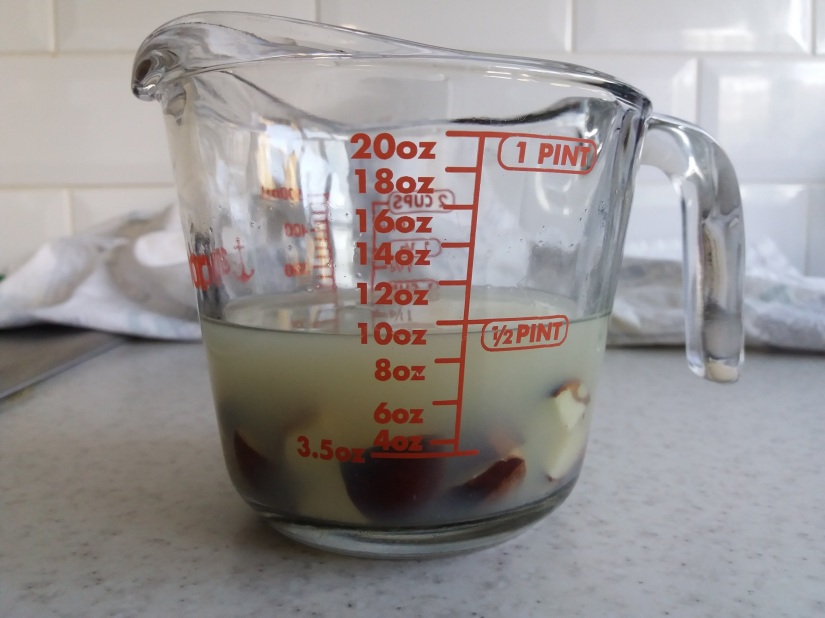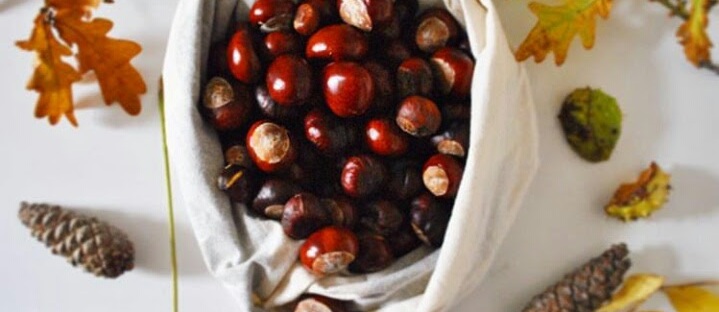I don’t know if you know this but it’s Autumn. Well, it is in the Northern Hemisphere at least. It kind of crept up on me to be honest. One minute it was a rainy Summer’s day and then it was suddenly a rainy Autumn day.

But I’m not here to complain about the British summer. I’m here to rejoice! It’s Autumn! I love Autumn. Walking through piles of crunchy orange leaves; foraging for berries; and this year, for the first time, foraging for conkers.

Conkers are the seeds of the horse chestnut tree. They are beautiful shiny seeds that we always collected as kids but not for the same purpose as I’m collecting them now. Gone are the days when we would collect them, punch holes in them, tie strings through them and bash them off other conkers. Now I want to use them to do the laundry. And that’s how I know I’m actually a grown up!
Conkers for laundry? What are you on about now Aoife! Well, going zero waste and trying to be more environmentally friendly are two sides of the same coin. There are lots of great eco-friendly detergents out there that don’t send nasty things down the drains to pollute water systems but they do happen to come in packaging, mostly plastic packaging and I’m trying to avoid that (in case you didn’t know). There are a few places that do refills of detergent and that’s great but what if you want to really go packaging free. What can you use instead?
I’ve been asked a lot recently about soap nuts. I’d never heard of soap nuts until a couple of months ago and now they seem to be everywhere. Soap nuts come mostly from India, where they have been used as laundry soap for a very long time. They grow on small trees and shrubs that are part of the Sapindus genus. The name derives from the latin Sapo, which means soap, and Indus, meaning India. The shells contain saponin, which is used for making soap. When the soapnuts are agitated in water they release the saponin and can clean whatever is in the water with them.
This is great. Nature, once again providing everything we need for daily life. Natural laundry soap, growing on trees. It’s fantastic but soapnuts may not be all that great for us. Not because they don’t work but because demand for them in the West makes them far more expensive for people local to where they are grown. That means those people turn to cheaper, nastier alternatives that are adding to water pollution in areas that already suffer from serious water pollution. Not cool.
There is also the question of the carbon footprint. The soapnuts need to be shipped from India. Most companies selling them celebrate the fact that they are shipped in bulk in freight containers, reducing their carbon footprint. This is great but wouldn’t it be even better if you had a natural soapnut for free with zero carbon footprint?
Well I guess it’s your lucky day because, right now, there are alternatives quite literally falling out of the trees all around you. Conkers contain saponin and they work almost exactly the same as soapnuts. The main difference is that the saponin is contained within the flesh of the conkers so you need to chop them up to release it.
I recently went for a walk in our local park and scooped up as many as I could find, which was plenty. I found this great article from Waste Land Rebel about how to use them to make laundry detergent. Here’s what I did and as a hark back to my secondary school science class notebook, I’ll write it like a proper experiment:
Experiment: Using horse chestnuts to make laundry soap.
Aim: To determine whether horsechestnuts, aka conkers, can be used in the same capacity as soapnuts, making them a free, biodegradable, eco-friendly alternative to generic laundry detergents.
Equipment: conkers (6), knife, chopping board, measuring jug, glass bowl, muslin/strainer, Lavender or tea tree oil (optional).
Method:
- I took 6 of my conkers (75g) and chopped them into 8ths.

Weighing my conkers. You can break them up in several ways; using your blender to get them really fine or smashing them with a hammer. I recommend the hammer or the knife because conkers are poisonous so you probably don’t want them anywhere near food related equipment. Cutting them into smaller pieces is good because it increases the surface area that water has to react with, which will help release the most amount of saponin. I imagine crushing them is probably the best way to do it, kind of like the way crushing garlic is the best way to produce all those lovely garlicy juices but that’s just a hypothesis. I haven’t tested anything other than the cutting so far.
- Then I placed them in a pyrex measuring jug and poured a cup of hot water over them.
- I left them sitting over-night but I could probably have used them quicker than that.
- Next day I gave the solution a swirl to mix the milky white liquid (it had separated into more solid and more watery parts).

The morning after - I grabbed a muslin from the baby’s stash and strained the mixture into a glass bowl.
- I added a couple of drops of lavender essential oil for a little bit of scent.

Bubbly laundry soap with a soothing lavender scent - Then, loaded up the washing machine with my towels and poured in about 2 fl.oz of the mixture (there was about 4 fl.oz in total).
- Switched on the machine.
- Added conkers to compost bin.
Results:
The machine was on and the towels were wet so I can presume that they are washed but I didn’t see any soap bubbles while the wash was on so I can’t say for certain if it was working or not. I know that probably sounds silly but what I mean is I don’t know if this process was any more successful than just washing the towels in hot water with no soap. They came out smelling fresh with a hint of lavender. They dried quite stiffly (I air dried them on the rack). This is probably because conkers contain a lot of starch. The Romans used sweet chestnuts to make flour, they are pretty much entirely full of carbohydrate, so it’s possible that horse chestnuts are similarly carbohydrate enriched. Makes sense they’d be starchy.
I washed some pale sheets next. They weren’t soiled or anything so once again can’t be sure of the cleaning quality.
I left the washing for a couple of days (not because I didn’t have any. I’ve a 7 month old. I live in a world made of laundry!) and came back to it with fresh ideas for how to make it work.
I once again chopped the nuts into 8ths but poured freshly boiled water over them and let them sit for about an hour or however long it took BB to stop feeding. Rather than straining the mixture into a bowl I laid the muslin over the liquid detergent tray in the washing machine and poured the entire mixture in. I added a drop or two of tea tree oil this time. I love the smell plus it’s naturally anti-bacterial so figured it would be a good idea. The test this time around was to see if it could clean the food stains from the cover of BB’s high chair. I of course took no pictures of the before and after but you’ll just have to trust me that before it was pretty gross and after it was good as new. I was really impressed with the outcome.
I reused the same conkers another three times, rather than just throw them out after the first go. I followed the same steps and by the second time I was definitely seeing soap bubbles in the pyrex jug when I stirred the mix. I felt like I was pushing it using them a fifth time, the mix seemed less thick so I stopped there. I could probably have squeezed another wash out of them if I’d left them sit for a while. I was happy with the results I got though.
Conclusions:
Using 6 conkers, chopped into 8ths, pouring boiling water over them and letting them sit for 30 mins/ until a milky white liquid was released, produced enough saponin enriched liquid to wash one load of washing. I used the same chopped conkers four times with similar cleaning results each time.
They were definitely good for lightly stained clothes but for serious stains you’ll probably need a spot cleaner or stronger detergent. Don’t use DIY laundry soap exclusively. Detergents are different to soap and are better for your machine and clothes, as is explained in this great blog post. Laundry soap requires more agitation than a modern machine can provide to really clean your clothes (soap is best used with a wash board) so over use of it can cause a build-up in your clothes and can clog your machine.
The left-over conker debris was put into my compost bin. I didn’t make any detergent in bulk but if you wanted to you could keep the liquid in the fridge for about a week before it goes off.
This was a free, vegan, seasonal, eco-friendly alternative to both conventional laundry soap and soapnuts. I got a little bit of exercise and fresh air collecting them and there is no carbon footprint associated with them. It is possible to dry the conkers out and keep them for use throughout the year. Wasteland Rebel recommends collecting about 11 lbs of conkers to see you through until the next foraging season. I think I’ll just use them as I find them for now but she has great tips on how to dry them on her blog.
Be careful how you store them. They need to have air flow around them if you’re keeping them whole, otherwise they’ll go mouldy. And remember, as fun as it is to go nuts and collect every single one you see, the squirrels need them more than we do, so forage respectfully. Leave some for the critters. Spread your foraging around and explore your local natural environment.

I had fun experimenting with these. I hope you’ll give it a go too.






This is amazing! Thanks for the tutorial!
LikeLike